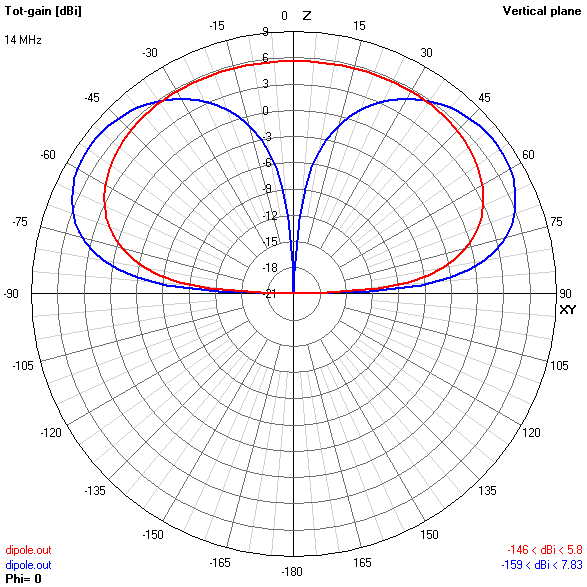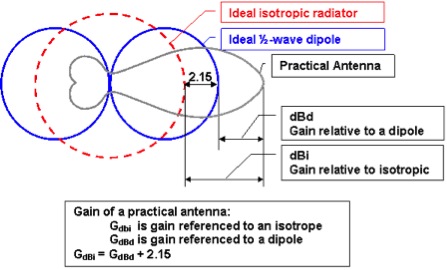Convert Dbd to Dbi
DBi Values Explained. DBd is a unit of measure for gain using a dipole as a reference.

What Is The Difference Between Dbi And Dbd Everything Rf
Power gain relative to the array antenna.

. So an antenna with a gain of 3 dBd has a gain of 515 dBi. Power at antenna connector in dBm antenna gain in dBi Effective Power transmitted by. For example for an antenna with a gain of 16 dBd when the gain is converted to dBi it is 1815 dBi.
The following equation represents the relationship between dBi and dBd. In that case the unit of measure is dBd Gain in dBd can be converted to dBi by adding 215 dB to the gain expressed in dBd. Dbi to dbm conversion dBi or dBisotropic is the forward gain of an antenna compared to the hypothetical isotropic antenna which uniformly distributes energy in all directions.
Enter the values in one or two of the text boxes and press the corresponding Convert button. A reference dipole antenna is defined to have 215 dBi of gain. I found the equation that can help you.
Sometimes a 5 dBi means hearing or not hearing a station. And i got -1837dB after that how i can convert it to dBi and do i have to consider the negative sign or i should ignore it. DBi is the measure of the strength of an isotropic antenna.
Some antenna manufacturers prefer to use dBi when specifying antenna gain because it results in a larger more impressive number. Generally the higher the gain dBi the narrower the beamwidth - the more directional the antenna. There is no performance difference between the two antennae.
Digi specifies all antennas in dBi only. Decibels to watts volts hertz pascal conversion calculator. The radiation in all directions is uniform relative to the power gain of the point source antenna.
DBd dBi - 215. That makes it look like they have the same or more gain as other antennas but subtract 215 dB from the. DBi is a measurement that compares the gain of an antenna with respect to an isotropic radiator a theoretical antenna that disperses incoming energy evenly over the surface of an imaginary sphere dBd compares the gain of an antenna.
DBi dBd 215. Hence to convert dBd to dBi just Add 214. With this logic antenna having gain of 7dBd will have gain of 914 in units of dBi.
The conversion is as follows. Im designing an antenna for my undergrand final year project. It is just the way that each vendor chose to specify each antenna.
You can convert dBi to dBm. 0 dBd 214 dBi. You have to calculate the hypothetical power trasmitted from an isotropic.
It is generally believed that dBi represents the same gain which is 215 larger than dBd. DBi dBd 215 dB. Decibels dB conversion calculator.
A reference dipole antenna is defined to have 214 dBi of gain. DBi dBm -215 dBi is theoretical because in the real world there is. Set the quantity type and decibel unit.
DBd dBi - 214. Convert 5 dBi to. So converting between dBi and dBd is as simple as adding or subtracting 215 according to these formulas.
0 dBd 215 dBi ProductsParts. There isnt a true conversion between dB and dBi. Therefore are two different quantities.
DBi dBd 215. Thanks in advance for helping me. Calculating ERP Start with dBd Keep as is NA Calculating ERP Start with dBiL dBiL - 215 Y NA Calculating EIRP Start with dBi Keep as is NA Calculating EIRP Start with dBic dBic - 3dB Y NA Calculating EIRP Start with dBd dBd 215 dB Y NA Calculating EIRP Start with dBiL Keep as is NA Common Antenna Gain Conversion Table.
Effective Isotropic Radiated Power EIRP. DBm or dBmW is the power relative to 1 milliwatt. DBi and dBd are used to measure the focusing power gain of antennas.
DBd compares the gain of an antenna to the gain of a reference dipole antenna defined as 215 dBi gain. The dBi value also reflects the. Whereas dBi uses an isotropic radiator.
In other words both 7dBd and 914dBi with respect to antenna gain are equivalent. Convert dB dBm dBW dBV dBmV dBμV dBu dBμA dBHz dBSPL dBA to watts volts ampers hertz sound pressure. The forward gain of an antenna measured in decibels dBi The dBi value reflects the antennas directional beamwidth characteristics ie directional as opposed to omnidirectional.
When the radio is in transmit the higher gain antennas achieve extra power apparent increase in power by focusing the power coming from the intentional. A reference dipole antenna offers a fixed 215 dB of gain over an isotropic antenna. DB is a measure of a ratio between two measurements.
Gain in dBd gain in dBi - 215 dB Gain in dBi gain in dBd 215 dB. Some companies present the gain of their antennas in dBi not dBd as most do. Revie Plex Series LPWANISMIoT Internal Antenna.
To convert dBi to dBd. So a 3dB antenna has the same gain as a 5 dBi antenna. So converting between dBi and dBd is adding or subtracting 214 according to these formulas.
Using HFSS i got the Gain without unit 0665 relative then i have conveted it to dB using this eq. The key is that dB and dBi are different units of measure antenna gain is confusing for this reason. DBi dBd 214.
Following formula mentions relation between dBd and dBi. Specifying antenna gain in dBd means that the antenna in question has the ability to focus the energy x dB more than a dipole. To convert from dBi to dBd just substract 214.
To convert from dBd to dBi simply add 215 to the dBd value to get the dBi value eg. DBd decibel relative to dipole The gain of an antenna can be measured relative to a reference dipole antenna and is expressed in dBd. Revie Pro Series LPWANISMIoT Internal Antenna.

Difference Between Db Dbi Dbm And Dbd What Is Db What Is Dbi What Is Dbm What Is Dbd Youtube

Radio Frequency Rf Field Intensity Units

Lora Lorawan Tutorial 5 Decibel Dbm Dbi Dbd Youtube

What Is The Difference Between Dbu Dbm Dbuv And Other Field Intensity Units Softwright Llc
Comments
Post a Comment